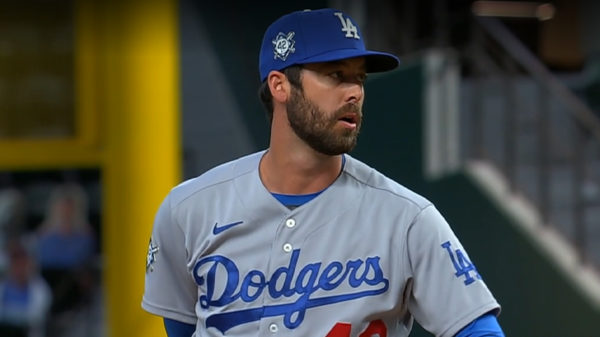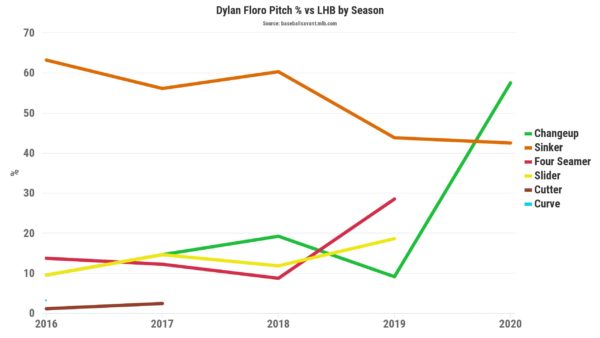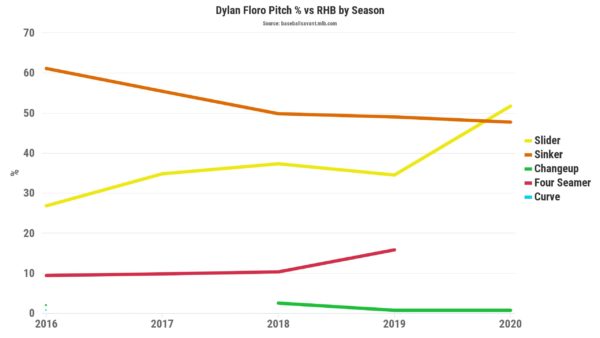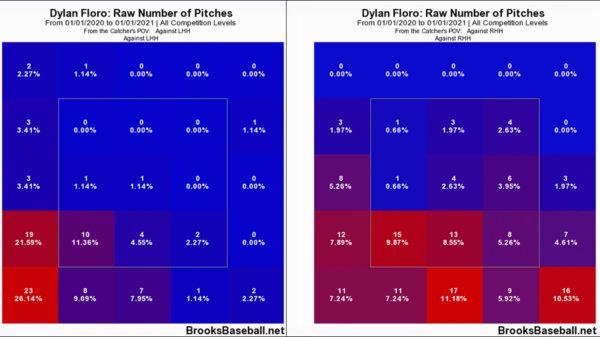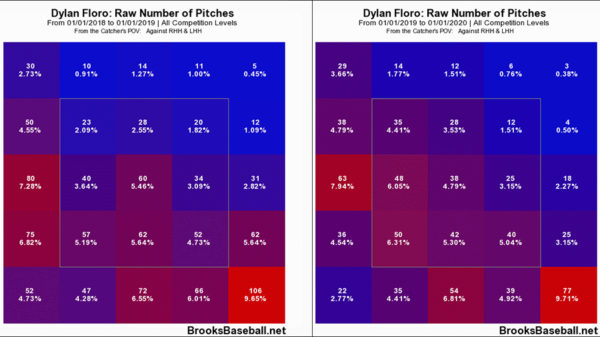I’ll start by saying this is much more information than you need on Dylan Floro on a season that’s rather hard to write features about. He’s pitched 15 2/3 innings across 16 games this season, second and first among Dodger relievers in both categories respectively, but that’s still a relatively small sample size.
However, we aren’t really given any other option this season. Either you write with a small sample size as the crux of an article or you pretty much don’t write at all considering we are 60% of the way through the regular season. That’s about the equivalent of being at 100 games in a regular year.
With that said, Floro’s rebound from a tough 2019 season has led to him playing a critical role in the Dodgers’ resurgent bullpen. With starters going 6 or more innings in just 11 of the Dodgers’ 36 games so far, Floro’s been a useful piece of bridging the gap to Kenley Jansen, Blake Treinen and a few others.
——
With just one run allowed, Floro’s ERA sits at 0.57 after Sunday along with a 1.98 FIP, 3.24 xFIP and 3.17 SIERA. He’s got the best rates of his career at LOB% (93.8), GB% (59.6), BB% (3.3) and exit velocity (83.8 mph), again with the understanding of the sample available. Similarly, Floro’s Hard Hit% is 13th-best according to Baseball Savant.
He’s not alone in many of the categories, as Treinen, Caleb Ferguson and league-leader Scott Alexander are each among the top 15 in GB% while Adam Kolarek and Brusdar Graterol are top 10 in BB%. Kolarek is also top 20 in exit velocity and Hard Hit% alongside Jansen. (All of these numbers are for pitchers with at least 10 innings pitched this season).
Really, it is hard to find much of a negative here:
The most notable change for Floro has been his pitch usage, with the Dodgers phasing out his four-seam fastball this season and upping his changeup to left-handed batters.
Here’s a look at 2020’s pitch usage overall:
And here it is by handedness of the batter.
With the increase in changeup usage has come a return to the pitch’s vertical drop level of 2018. Just about every other pitch looks similar to what it was a year ago.
As shown above, Floro’s about 52% to 48% to righties with his slider and sinker. The slider, used 34.5% to right-handers last season, effectively replaced the four-seam usage with the sinker holding steady.
As for left-handed batters, Floro’s sitting at 57.5% change and 42.5% sinker, the latter again at nearly the same rate as a year ago. However, the lack of four-seamers and sliders means Floro’s change as risen rapidly from its 9% rate from a year ago (and well past 2018’s 19.2%).
Floro’s also kept pitches lower to lefties this season, which really is just stating the obvious with the move away from a fastball to a changeup. Specifically to lefties, he’s had a clear plan of attack while getting the ball down more in general than the previous two seasons. Again, none of this is truly news once you see he isn’t throwing a four-seamer.
For reference, this is 2018 overall on the left and 2019 on the right.
Just how successful has that plan of throwing changeups down to lefties been?
A Whiff% of 33.3 with an exit velocity of 82? That’ll work. Floro’s changeup actually sits at 2.9 runs above average and 6.65 runs above average per 100 pitches. That’s 20th and 10th in baseball according to Fangraphs.
One final note on all of this is Floro’s O-Swing% and O-Contact%, which sit at 37.0% and 70.6%. For the league, that’s tied for 30th and 67th, but are also the best he’s posted during his time with the Dodgers and well ahead of his career averages.
Again, this is probably an obvious result when you see he’s not walking batters, and living down and away to batters on both sides of the plate. None the less, it is another reason you’re seeing an exit velocity and Hard Hit% as low as they are.
——
So what does that usage all mean?
Well, not much as of now. Yes Floro’s been better against lefites than he has at any other point in recent memory, but it has come against just 24 batters. Floro’s holding lefties to a .136/.167/.136 line across the 7 1/3 IP with one intentional walk among the baserunners allowed. In 2019, it was .339/.426/.508 against 68 batters and 2018 was .292/.353/.404 against 102 batters. Sure there’s plenty of time for it to change this season, but that’s a pretty drastic swing.
Unfortunately the same can’t be said about his work against righties right now. A .314/.324/.429 line to 37 batters this season is up from 2019 (.211/.252/.309 against 133 batters) and 2018 (.204/.271/.289 against 169 batters).
The one possible (and simple) explanation for that may be the slider is simply not being hit on the ground as much as it was in the past. Each one of the point below is a relatively random sample size based on the months of his career, but the slider is rather low while only being used against right-handed hitters.
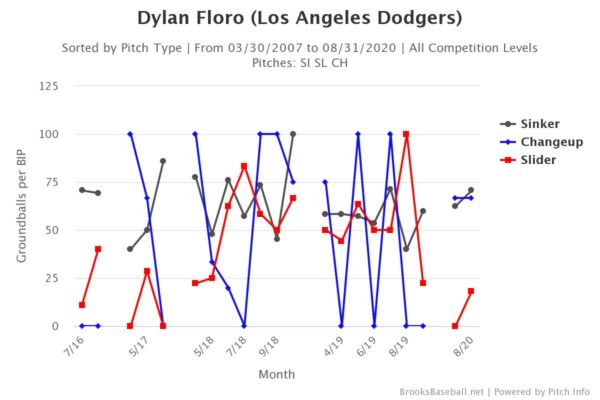
——
Amazingly, that seems to mean Floro has some room to improve his numbers even further, or at least cancel out some regression should his numbers against lefties move back toward his previous history.
Most of this can be invalidated by one bad outing this week, with the numbers capable of moving pretty rapidly in either direction (especially when split up by handedness).
However, it seems Floro and the Dodgers figured out something with the changeup to counter left-handed batters and that’s worth keeping an eye on for the rest of the season.
 Dodgers Digest Los Angeles Dodgers Baseball Blog
Dodgers Digest Los Angeles Dodgers Baseball Blog
